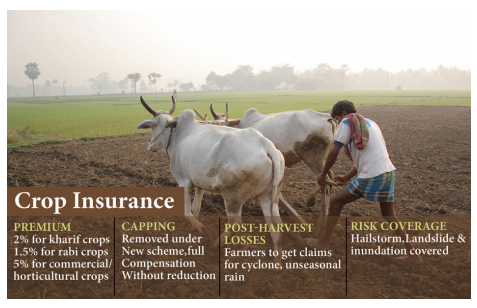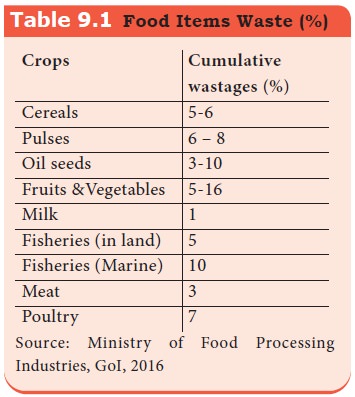Economics - Impact of LPG on Agricultural Sector Reforms - Development Experiences in India | 11th Economics : Chapter 9 : Development Experiences in India
Chapter: 11th Economics : Chapter 9 : Development Experiences in India
Impact of LPG on Agricultural Sector Reforms - Development Experiences in India
Impact
of LPG on Agricultural Sector Reforms
Since the
inception of economic reforms, Indian economy has achieved a remarkable rate of
growth in industry and service sector. However, this growth process bypassed
the agricultural sector, which showed sharp deceleration in the growth rate
(3.62 percent during 1984/85 – 1995/96 to 1.97 percent in 1995/96 – 2004/05).
The sector has recorded wide variations in yield and productivity and there was
a shift towards cash crop cultivation. Moreover, agricultural indebtedness
pushed several farming households into poverty and some of them resorted to
extreme measures like suicides.
1. Crop Insurance
Agriculture
in India is highly prone to risks like droughts and floods. It is necessary to
protect the farmers from natural calamities and ensure their credit eligibility
for the next season. For this purpose, the Government of India introduced many
agricultural schemes throughout the country.

The
Pradhan Mantri Fasal Bima Yojana (Prime Minister’s Crop Insurance Scheme) was
launched on 18 February 2016.
It
envisages a uniform premium of only 2 percent to be paid byfarmers forKharif
crops and 1.5 percent for Rabi crops. The premium for (annual) commercial and
horticultural crops will be 5 percent.
2. Cold Storage
India is
the largest producer of fruits and second largest producer of vegetables in the
world. In spite of that per capita availability of fruits and vegetables is
quite low because of post harvest losses which account for about 25% to 30% of
production. Besides, quality of a sizable quantity of produce also deteriorates
by the time it reaches the consumer. Most of the problems relating to the
marketing of fruits and vegetables can be traced to their perishability.
Perishability is responsible for high marketing costs, market gluts, price
fluctuations and other similar problems. In order to overcome this constraint,
the Government of India and the Ministry of Agriculture promulgated an order
known as “Cold Storage Order, 1964” under Section 3 of the Essential Commodities
Act, 1955. However, the cold storage facility is still very poor and highly
inadequate.
3. Post Harvest measures
The
annual value of harvest and post-harvest losses of major agricultural produce
at national level was of the order of Rs.92,651 crores, calculated using
production data of 2012-13 at 2014 and wholesale prices, estimated by the
Indian Council of Agricultural Research (ICAR).

Kisan Credit Card Scheme
A Kisan Credit Card (KCC) is a credit delivery mechanism that is
aimed at enabling farmers to have quick and timely access to affordable credit.
It was launched in 1998 by the Reserve Bank of India and NABARD. The scheme
aims to reduce farmer dependence on the informal banking sector for credit

The card is offered by cooperative banks, regional rural banks and public
sector banks. Based on a review of the working of the KCC, the government has
advised banks to convert the KCC into a smart card cum debit card.
In order
to reduce wastage of agricultural produce and minimize post-harvest losses, the
Ministry of Food Processing Industries (MoFPI) has implemented various
components of Central Sector Schemes, namely:
Mega Food
Parks; Integrated Cold Chain; Value Addition Preservation Infrastructure;
Modernization of Slaughter house
Scheme
for Quality Assurance; Codex Standards; Research and Development and Other
promotional activities.
Further,
the GoI extended support to arrest post harvest losses of horticulture and
non-horticulture produce and to provide integrated cold chain and preservation
infrastructure facilities from the farm gate to the consumer or from the
production site to the market since 2008-09. However, the improvement is not
visible for it is not substantial.
4. Agricultural Produce Market Committee
Agricultural
Produce Market Committee (APMC) is a statutory body constituted by state
government in order to trade in agricultural or horticultural or livestock
products.
Functions of APMC
Functions
of APMC are:
1.
To promote public private partnership in the ambit
of agricultural markets.
2.
To provide market led extension services to farmer.
3.
To bring transparency in pricing system and
transactions taking place in market in a transparent manner.
4.
To ensure payments to the farmers for the sale of
agricultural produce on the same day.
5.
To promote agricultural activities.
6.
To display data on arrivals and rates of
agricultural produce from time to time into the market.
Agrarian Crisis after Reforms
a. High input Costs:The
biggest input for farmers is seeds. Before liberalisation, farmers across the country had access to seeds from state
government institutions. The institutions produced own seeds and were
responsible for their quality and price. With liberalization, India’s seed
market was opened up to global agribusinesses. Also, following the deregulation
many state government institutions were closed down in 2003. These hit farmers
doubly hard: seed prices shot up, and fake seeds made an appearance in a big
way.
b. Cutback in agricultural subsidies: Farmers
were encouraged to shift from growing a mixture
of traditional crops to export oriented ‘cash crops’ like chill, cotton and
tobacco. Liberalisation policies reduced the subsides on pesticide, fertilizer
and elasticity. As a result prices have increased by 300%. However, the prices
of agricultural goods have not increased to that extent.
c. Reduction of import duties: With a view to open India’s markets, the
liberalization reforms also withdrew
tariffs and duties on imports. By 2001, India completely removed restrictions
on imports of almost 1,500 items including food. As a result, cheap imports
flooded the market, pushing prices of crops like cotton and pepper down.
d. Paucity of credit facilities: After
1991 the lending pattern of commercial banks, including nationalised bank drastically changed. As a result, loan
was not easily adequate. This has forced the farmers to rely on moneylenders
who charge exorbitant rate of interest.
Related Topics